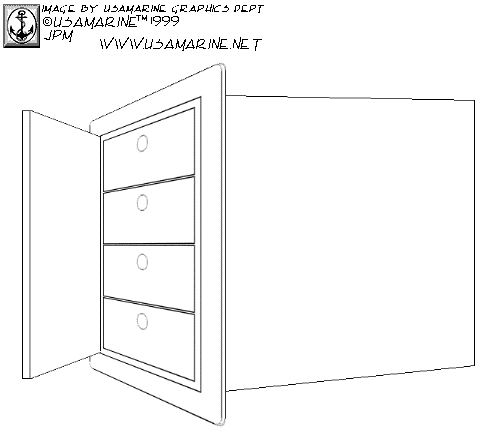
PVC Foam Board as an Alternative to Plywood
The following discussion came about by Russ King's musings over alternative boatbuilding materials. Since I've done a fair amount of fabrication with PVC Foam Board, I felt that this might be worthwhile to others who may have missed it on the bulletin board.

One modern material, that has received little or no attention for building a boat itself, is expanded PVC Foam Board. I use the stuff a lot for such items as tackle center casings and drawers, battery boxes, light weight doors and molding replacements that will either be painted or laminated. I usually use it in conjunction with polyethylene, (Seaboard, Starboard), exterior facings if the item isn't going to be painted. Also to be a replacement for plywood normally used for backing boards on such upholstered exterior items as bolsters, seats, benches, etc. I just finished a 4 drawer tackle center for a small boat that is fully recessed into the console. The face molding, door and drawer faces are polyethylene, the rest PVC. I'll have that project up on the web within a week or so. The cost for 4x8 sheets is comparable to marine ply, but when you back out the cost of epoxy encapsulation, it's less expensive by a third if you're not counting the cost of labor. Throw labor in and it's well under half the expense. It's dissimilar to plywood in the respect of rigidity, (it's fairly limber by comparison), and it won't hold epoxy laminations as well as wood. But it is rot proof, UV resistant, easy to work with, non-toxic, stable, holds a fastener reasonably well, easily glued, (PVC cement), or hot air welded, water proof, highly paintable, and fairly easy to obtain through a variety of plastics dealers. It takes well to a number of other adhesives, including, polyurethane, polysulfide, epoxy, contact cement, resorcinol, etc. Easy to fabricate using saw, drill, & power sanders. Faces are hermetically sealed and smooth, interior is somewhat course and on the spongy side. Cell structure is closed, will not absorb water. Can be heat and vacuum formed. Tortures easily, compound curves and shapes are no problem, but heat would be required. If anybody wants to experiment with PVC Foam Board. and can't find a local source, call Mike at Sunray Plastics in Riviera Beach, FL - 561.844.7722. He'll ship, or drop ship, anywhere in North America. Be sure you tell him I gave you his phone number... Thicknesses available range from 1/8" through several inches. Standard increments of 1/8". Virgin material is white. Reconstituted, which is denser, better machining, & lower cost is deck grey. Other PVC extrusions are common. Pipe, angle, & rod stock. The specific brand name I use is: VersacelTM (Rigid PVC Foam Board) For other sources, try HPG International, Inc. and check through their Distributor List... Calculations show PVC Foam Board to be approx. 26% lighter than Plywood For quick comparison:
1 lb = 0.37 kg (3.2 lbs = 1.18 kg) 1 sq ft = 0.093 sq meter 10.76 sq ft = 1 sq meter Based on 15" x 6 1/4" cantilevered run under 18.5 lbs of pressure. sample PVC deflection = 3.50" sample plywood deflection = 0.625" deflection ratio pvc : ply = 5.6 : 1 Actually this deflection ratio is rather ambiguous, since the closer the end length is to the fulcrum, the more pressure needed to effect the same deflection distance, and vise versa. But this little test shows graphically the difference of flexibility between the two materials. This section of the boatbuilding tips was hastily done and will undoubetly be expanded as dicussion and thoughts progress. Check back from time to time. Email me with any comments and ideas that you might have... Have fun! Feel free to download and print these drawings, but please don't use it on a website without linking it to Bertram31.com. Capt Patrick McCrary Bertram31.com 834 Scott Dr., LLANO, TX 78643 Telephone 325.248.0809 Web site questions or comments to: bertram31@bertram31.com |
